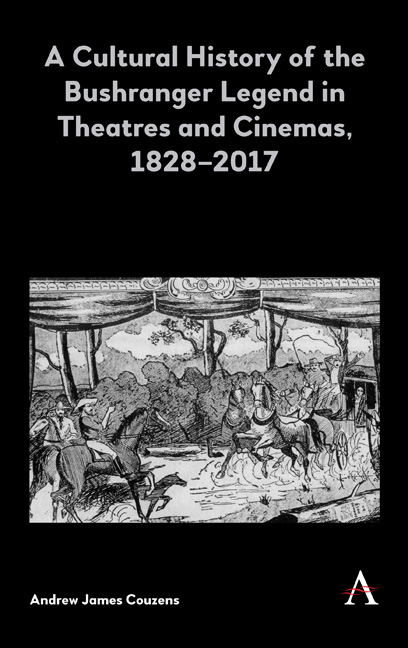Book contents
- Frontmatter
- Contents
- List of Figures
- Acknowledgements
- Introduction: Defining the Bushranger Legend
- Part 1 Establishing the Legend
- Part 2 Developing the Legend
- Part 3 Fragmenting the Legend
- 9 Historical Revisionism and the Bushranger Legend
- 10 Diversification and Inclusiveness of the Bushranger Legend
- 11 Globalization of the Bushranger Legend in Outlaw Road Movies
- Conclusion
- Bibliography
- Index
10 - Diversification and Inclusiveness of the Bushranger Legend
from Part 3 - Fragmenting the Legend
Published online by Cambridge University Press: 14 February 2019
- Frontmatter
- Contents
- List of Figures
- Acknowledgements
- Introduction: Defining the Bushranger Legend
- Part 1 Establishing the Legend
- Part 2 Developing the Legend
- Part 3 Fragmenting the Legend
- 9 Historical Revisionism and the Bushranger Legend
- 10 Diversification and Inclusiveness of the Bushranger Legend
- 11 Globalization of the Bushranger Legend in Outlaw Road Movies
- Conclusion
- Bibliography
- Index
Summary
The introspection and conflict that the Bicentenary provoked destabilized Australia's cinematic bushranger legend as seen in the deconstructive tendency of cinematic revisionism outlined in the previous chapter. However, this destabilization created space for more inclusive versions of the bushranger legend. Where the legend had previously been the domain of white bushdwelling men, political and social developments allowed Aboriginal people, women and even children, to fulfil the role of the heroic bushranger. These new representations appropriated mainstream Australian cultural myths, supporting cultural participation and inclusion of traditionally marginalized groups. However they also tactically reinforced the legends, reassuring mainstream Australia of their moral validity by integrating marginalized cultural groups. This latter purpose aligns with what Damian Short considers to be the underlying aim of the reconciliation agenda, which he claims, ‘exhibited a subtle yet pervasive nation building agenda that appeared to offer “postcolonial” legitimacy via the “inclusion” of previously excluded Aboriginal peoples, but which actually served to weaken Aboriginal claims based on their traditional “separateness” from settler culture’.
Broadening the scope of the representational traditions of the bushranger legend has created a feedback loop that undermines some of the legend's stability. Many of these films are not bushranger films directly, but they nevertheless apply important characteristics of the bushranger legend to their protagonists, resulting in a complex negotiation between the cultural authenticity of the legend and that of the identities to which it is applied. The increased inclusivity of the bushranger legend fragments its very nature.
Although this cinematic tendency reflected a shift in the representation of a broad spectrum of ethnic and gender identities, its most productive application has been to films acknowledging Indigenous dispossession. In fact the majority of this chapter is dedicated to this specific implementation of the tendency, with a brief outline of its application to migrant characters at the end. The reason I give so much attention to one facet of the approach I am detailing here is partly because it is the most common implementation of this tendency but also because it is the implementation with the greatest cultural meaning and the greatest implications for the bushranger legend. In fact the implications of the bushranger legend for Indigenous people received cinematic attention a decade before the catalyst of the Bicentenary in Fred Schepisi's The Chant of Jimmie Blacksmith (1978). Jimmie Blacksmith was a precursor to the legend's more complete dismantling to come.
- Type
- Chapter
- Information
- Publisher: Anthem PressPrint publication year: 2019



